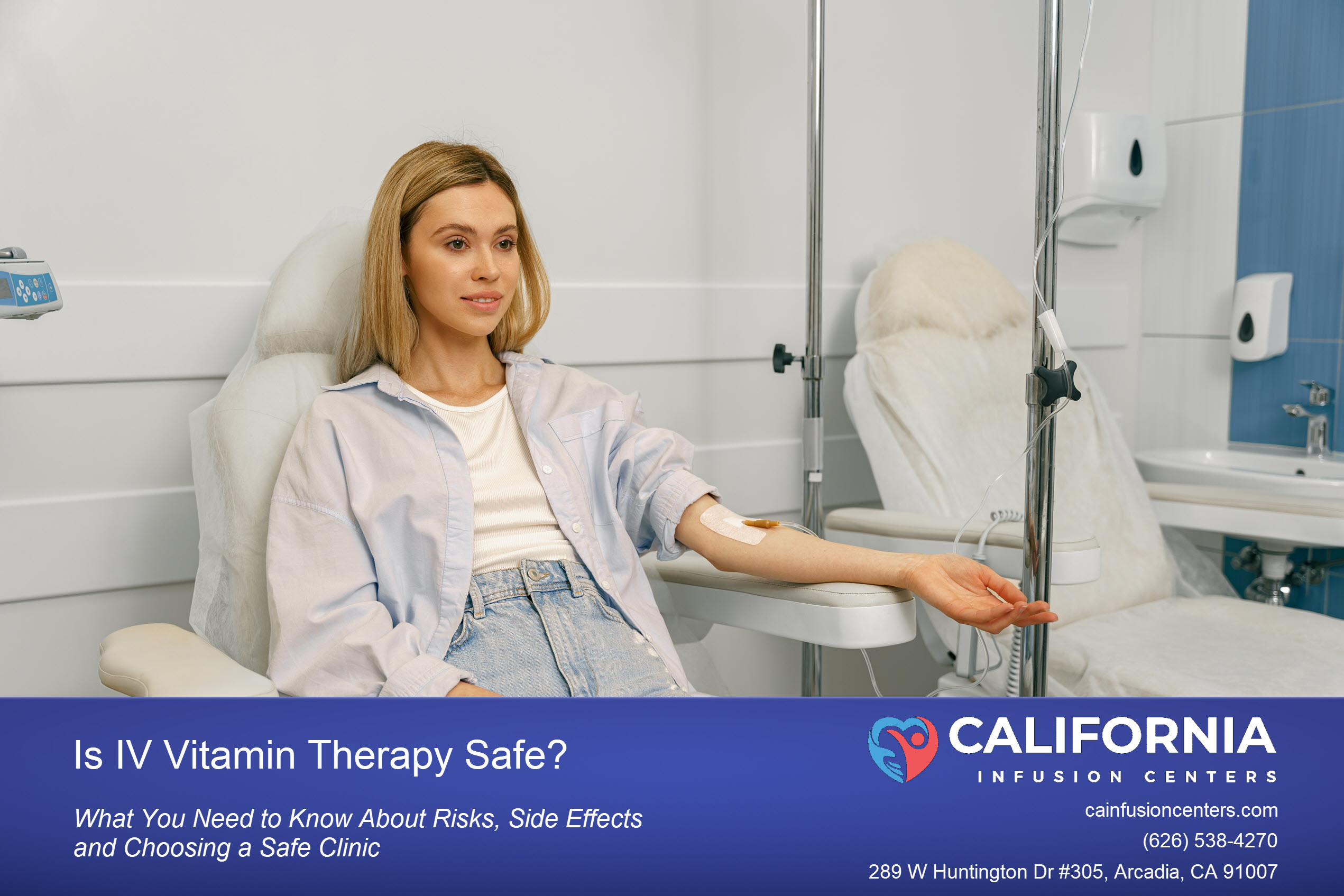Home » IV Vitamin Therapy » Is IV Vitamin Therapy Safe?

Resource Contents
The popularity of IV drips has raised important questions about their safety. Patients want to know if wellness infusions carry the same level of clinical oversight as hospital IV therapy. The short answer is that IV vitamin therapy can be safe when it is delivered by licensed nurses under physician supervision in a setting that follows medical standards.
Intravenous therapy is not new. Hospitals have used IV routes for decades to correct dehydration, deliver medications and restore electrolytes. The same pharmacology applies when vitamins or minerals are administered. The difference lies in the clinical indication and whether the infusion is tailored to a documented need or offered as a wellness service.
For those considering IV therapy outside of a hospital, the key to safety is ensuring the clinic operates with the same safeguards as any outpatient medical setting. Learn more about the foundations of IV therapy here: What Is IV Vitamin Therapy.

Like any medical procedure, IV vitamin therapy has potential side effects. The most common are mild irritation or bruising around the vein. Some people also notice temporary warmth, lightheadedness or a metallic taste during the infusion.
More serious complications are rare but possible. Infection can develop if sterile technique is not followed, which is why CDC injection standards matter. Vein inflammation or phlebitis may occur if the infusion irritates the vessel wall. High concentrations of electrolytes can sometimes cause imbalances without careful monitoring, and allergic reactions are possible if you are sensitive to certain ingredients. Choosing a clinic with licensed providers and emergency protocols helps reduce these risks.
When IV therapy is performed under licensed clinical supervision, the risk of serious complications is low but it is never zero.
IV vitamin therapy is not right for everyone. Patients with kidney disease, congestive heart failure, or genetic conditions such as G6PD deficiency face higher risks and should avoid elective infusions unless prescribed.
People with active infections or unstable medical conditions may also be at greater risk. For pregnant or breastfeeding patients, IV therapy should only be considered with approval from their physician. A thorough intake process helps determine when IV vitamin therapy is safe and when another option is better.
According to the Mayo Clinic, evidence for broad wellness use is still limited, so weighing risks against proven benefits is important.
The difference between a safe IV therapy session and one that carries unnecessary risk often comes down to the clinic’s protocols. Patients should expect:
IV therapy should be performed by a registered nurse with appropriate orders and supervision. California scope and supervision requirements are defined in the Nursing Practice Act and Board of Registered Nursing regulations.
All IV solutions should be prepared according to USP <797> Pharmaceutical Compounding. These standards reduce contamination risk and set requirements for cleanrooms, aseptic technique and beyond-use dating. A practical overview is also available from the AANA on USP <797>.
Clinicians must follow the CDC injection safety guidance, including single-use needles and syringes, proper hand hygiene, skin prep and correct handling of multi-dose vials.
Medical-grade infusion clinics keep emergency medications and equipment on site and train staff to respond promptly to reactions. This preparedness is a core patient-safety requirement and should be part of every visit’s monitoring plan.
At California Infusion Centers, you can learn more about how these safeguards are built into our approach here: Our Process.
In California, patients have access to a wide range of IV therapy providers, but standards vary. The safest clinics follow a model similar to outpatient infusion centers, where care is nurse-led and overseen by a physician.
For patients in Arcadia, Pasadena and Greater Los Angeles, choosing a clinic means looking beyond amenities. Reclining chairs and a quiet space are important, but the priority should be licensed care, ingredient transparency and clear communication about risks.
Our team at California Infusion Centers in Arcadia provides infusions in a modern, private setting with easy access and free parking. This combination of comfort and oversight makes treatment both safe and accessible. To learn more about available services, visit Vitamin Therapy.
While IV fluids and many vitamins are FDA-approved for medical use, the practice of combining nutrients for wellness is considered off-label. Safety relies on clinical oversight and adherence to pharmacy standards.
Any time a catheter enters a vein there is a risk of infection, which is why sterile protocols and CDC standards are essential. In a properly managed clinic, infection rates are very low.
Frequency depends on your health goals and medical history. Some patients receive a one-time infusion for hydration after illness while others schedule monthly sessions for ongoing support. A consultation helps determine the right cadence.
Licensed providers are trained to manage IV complications, including allergic reactions or infiltration. Emergency medications and monitoring should always be available on site.
IV vitamin therapy can be safe when matched to the right patient, performed under licensed supervision and guided by strict infection control practices. Risks exist, but they are minimized when clinics follow standards set by USP <797> and the CDC.
If you are considering IV therapy for hydration, deficiency correction or recovery, the safest approach is to start with a consultation. Discuss your goals, health history and any lab results with a licensed provider before beginning treatment.
To explore your options, schedule a visit or learn more about our services here: Book Appointment.
Your health deserves both comfort and clinical oversight. At California Infusion Centers, every infusion is nurse-led, compounded to the highest safety standards, and delivered in private suites designed for your peace of mind.
Whether you are considering IV vitamin therapy for hydration, recovery, or immune support, we make safety the foundation of your experience.
Call: (626) 538-4270
Email: info@cainfusioncenters.com
California Infusion Centers, located in Arcadia, CA, offers IV Vitamin Therapy for patients throughout Arcadia, Pasadena, Los Angeles and surrounding areas.
Disclaimer:
This page is educational and is not a substitute for medical advice, diagnosis or treatment. Decisions about IV vitamin therapy should be made with a licensed clinician who knows your medical history and goals.